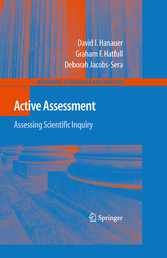Suchen und Finden
Acknowledgments
7
Contents
9
to 1 Active Assessment
13
1.1 Scientists as Educators
13
1.2 The Context and Aims of This Book
13
1.3 Relevant Historical Developments in Science Education
14
1.4 Active Assessment Defined
15
1.5 The Underpinning Principles of Active Assessment
16
1.6 On the Importance of Active Engagement
18
1.7 The Design of This Book
20
to 2 Conceptualizing Scientific Inquiry
22
2.1 Introduction
22
2.2 The Diversity of Scientific Inquiry
22
2.3 The Characteristics of Authentic Scientific Inquiry
26
2.4 An Analytical Framework for the Definition of Scientific Inquiry
28
2.5 Chapter Summary
31
to 3 An Introduction to Assessment
33
3.1 Assessment and Science
33
3.2 Assessment, Evaluation, and Testing
33
3.3 Summative, Formative, and Diagnostic Assessment
34
3.4 Distinctions in Elicitation Methods
35
3.5 Developing an Assessment Program
36
3.6 Chapter Summary
39
to 4 Assessing Scientific Inquiry
40
4.1 Introduction
40
4.2 Approaches to the Assessment of Scientific Inquiry
40
4.3 Authentic Assessment
46
4.4 The Characteristics of Authentic Scientific Inquiry Assessment (ASIA)
48
4.5 Active Assessment Development
50
4.6 Chapter Summary
51
to 5 An Analytical Framework for the Development of Scientific Inquiry Assessment
53
5.1 Introduction
53
5.2 Stages of Active Assessment Development
53
5.2.1 Stage 1: Empirical Description of Scientific Inquiry
54
5.2.2 Stage 2 -- Definition of Aims
57
5.2.3 Stage 3: Tool Development
58
5.2.4 Rubric Development
59
5.2.5 Assessment Piloting
62
5.3 Chapter Summary
62
to 6 The PHIRE Program
63
6.1 Introduction
63
6.2 What Are Phages?
64
6.3 Bacteriophages Are Ubiquitous and Host Specific
66
6.4 Bacteriophages: The Dark Matter of the Biological Universe
67
6.5 Goals of the PHIRE Program
68
6.6 The Power of Discovery
68
6.7 PHIRE: A Ten-Step Program
69
6.7.1 Step 1: Phage Isolation
69
6.7.2 Step 2: Phage Purification
70
6.7.3 Step 3: Phage Amplification
70
6.7.4 Step 4: Electron Microscopy
71
6.7.5 Step 5: Nucleic Acid Extraction and Restriction Analysis
72
6.7.6 Step 6: DNA Sequencing
74
6.7.7 Step 7: Genome Annotation
75
6.7.8 Step 8: Comparison of the DNA Sequence to Known Phage Genomes
75
6.7.9 Step 9: Comparative Genomic Analysis
77
6.7.10 Step 10: Publication
80
6.8 Is That All?
80
6.9 Whats in a Name?
81
6.10 Whos Qualified for the PHIRE Program?
82
6.11 Parallel Projects: Pros and Cons
82
6.12 Mentees and Mentors: Opportunities and Responsibilities
83
6.13 Scheduling and Flexibility
84
6.14 Multiple Milestones of Success
84
6.15 Not All Failure Is Bad
85
6.16 Transitions: From Concrete Beginnings to Abstract Representation
85
6.17 Seven Attributes of the PHIRE Program
86
6.17.1 Attribute 1: Technical Simplicity with Transition to Complexity
86
6.17.2 Attribute 2: Conceptual Simplicity with Transition to Complexity
87
6.17.3 Attribute 3: Flexible Scheduling Compatibility
87
6.17.4 Attribute 4: Multiple Achievement Milestones
87
6.17.5 Attribute 5: Parallel Projects and Mentoring
87
6.17.6 Attribute 6: Authentic Publishable Research
87
6.17.7 Attribute 7: Project Ownership
87
to 7 The PHIRE Program Assessment Strategy
88
7.1 Introduction
88
7.2 Aims of Undergraduate Phage Hunting
88
7.3 Detailed Analyses of Decision-Making Reasoning and Calculation in the Bacteriophage Isolation and Identification Process
90
7.3.1 Phage Isolation -- Identification Through Infection
91
7.3.2 Phage Purification Through Selective Infection
92
7.3.3 Phage Amplification -- Measuring Bacteriophage Concentration to Determine and Produce Maximum Bacteriophage Yield
93
7.3.4 Electrophoresis
94
7.3.5 Gene Determination (Annotation)
95
7.4 An Educational Assessment Strategy for the Scientific Inquiry Process of Phage Hunting
101
7.5 Weighting and Timing
104
to 8 PHIRE Assessment Tools
106
8.1 Introduction
106
8.2 The Substantive Knowledge Test
106
8.3 The Physical Checklist
107
8.4 The Visual Literacy Test
108
8.5 The Notebook Assessment Tool
110
8.5.1 Program Beginnings and Notebook Introduction
111
8.5.2 On-Going Laboratory Notebook Usage and the Provision of Feedback
113
8.5.3 Final Assessment of Laboratory Notebooks (End of Program)
114
8.6 The Knowledge Presentation Performance Test
117
8.6.1 Conference Poster Development
118
8.6.2 Conference Poster Presentation
119
to 9 Reflections from an Active Scientist-Educator
121
9.1 Introduction
121
9.2 Two for the Price of One: Integrating the Missions
122
9.3 Some Practical Concerns
123
9.3.1 Space: The Final Frontier
123
9.3.2 Money and Time
124
9.4 Why Bother with Assessment?
124
9.5 Program Attributes Revisited
125
9.6 Summary and Conclusions
126
Index
133
Alle Preise verstehen sich inklusive der gesetzlichen MwSt.








